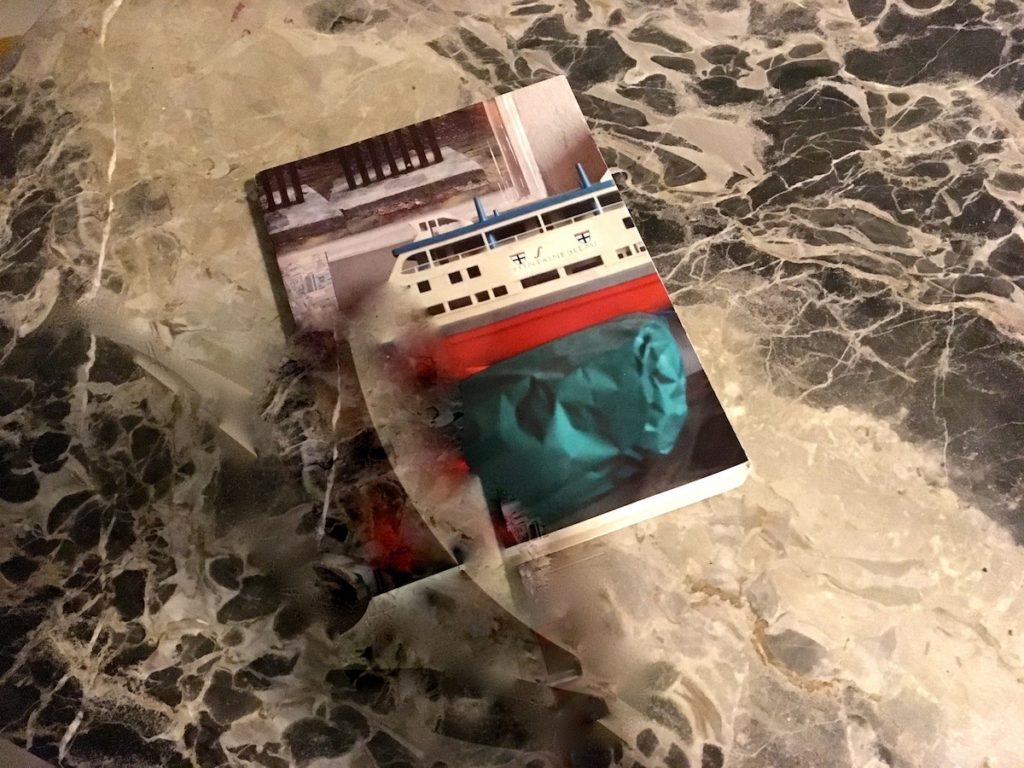Wrapped as a present with a paper cover signed by an artist (Manfred Pernice who plays with etymology, Fointenbleau and the collage), Stationary 1 is not for sale and is not designed to adhere to the rules of circulation that anyone imagines, and follow, for books marketing.
It is an annual collection, and this is the first volume (the second is above to be launched), hosting very varied pieces – one different from the other in genre and very pioneering the narrative.
They practice a new form of prose (and also of poetry/prose, as the writings of Fayen d’Evie and George Szirtes) and sui generis essaying on contemporary art. Among these last examples (the majority) the most outstanding are two: the one signed by Quinn Latimer who overrides the boundary between public and private; the one signed by Sarah Lehrer-Graiwer who drenches in the meteor-like art by Piero Golia (and, so, the LA scene), by describing one of his last brainchildren, the Chalet.
These writings stand for a very primordial genre as they are collected, but are also the output of an art residency (especially encouraging the act of writing) that has been designed and hosted by a non-profit space located in Hong-Kong (Spring Workshop) that also published the not for sale book.
One day the postman slides a copy of Stationary 1 in the slip on my door. It is always awesome to listen to books arriving in – they fall in such a diverse way from anything else, the magazines, the objects.
ichuff clat clat on the marble eroded by the Venetian salt.
I so discover about the meta-literary collection and about the 18 great works included in. First I’ve eaten them fast because I was curious, then I sat down slowly – again and again – to read them back and to weigh them. Of course these writings are not the type of fast reading from cover to cover.
They require to be filtered, read back, re-thought – especially for the ones like me who are daily in contact with arts and its paraphernalia.
They slept with my cat who was maybe smelling (and loving) the prints another feline left on it.
They travelled with me for many miles in all the directions. I moved on speaking about them now when I’m flying over the Arabic peninsula and the Iraqi arm entered in Mosul while I’m just over Baghdad – we do not know who is fighting or agreeing with; my country is surviving to the hundredth earthquake that this time is democratic because it brings terror (and link them in it) either the north inhabitants (used to refrain earthquake in the racist stadium songs and beyond against the south ones), the centre ones where it originated and the poor south ones, already very experienced about.
The will of Spring Workshop is to encourage the reading and the distribution of the book thanks only to the word of mouth (so, you’re invited to check the stories, and the libraries and bookshops where to find the paper version all around the world, also on www.stationarystories.com) as they have the will to design residencies for artists, curators and pure writers in order they can really detach from their usual struggle and hurdles of their practice and researches to try to fulfill themselves with a month or so of introspection. To flirt day by day with their obsessions – detached from any urgency and availability.
The stories will grab you as they were microcosms and each will weigh to you differently – from the tears to the laughs, from the levity to the tragedy. None of them can be considered better than the others, their register (and the personality of the authors) is so different and so well cultivated that it’s pure pleasure to dig into something that could stand very far – for interests, methodologies or ways – from what usually is appealing.
The consequences of this reading can’t be computable: every piece is intellectively (and culturally) very rich, so therefore it could kidnap you and drive you far to take information about what it deals about – either if a museum, an artist, a publisher, an artist’s book, pure Situationism and much more.
If you never heard about artists’ residencies – and before entering the no-man land maybe knocking to the wrong door by ending trouped in something will castrate you – let’s try to take in consideration a narration out of the beaten track like this.
I, on my side of observation, filled a notebook with names, situations and things I would immediately explore and I confirmed again to myself that Quinn Latimer has the most powerful and innovative critic writing in the actual visual art scene. Nothing is so original like her writings.
I then have just discovered a small genius, she is called Rosemary Heather, I was not aware about her work and will run into it.
I have to thank Mandy for all this astonishment, she sent me the book that was within a handwritten small card – this sentence struck me ‘let this book be your excuse to abandon the many things you need to do today and embrace the stillness of a suspended moment’.
I accepted with great pleasure her suave invite and I already regret that that ‘suspended moment’ – even if retained as long as possible to do not let it vanish – is already ended. To continue the trajectory of this rare magic, I have already chosen the public library where I would love to donate the book. It is just few steps by home and is devoted only to art catalogues, books and magazines.
